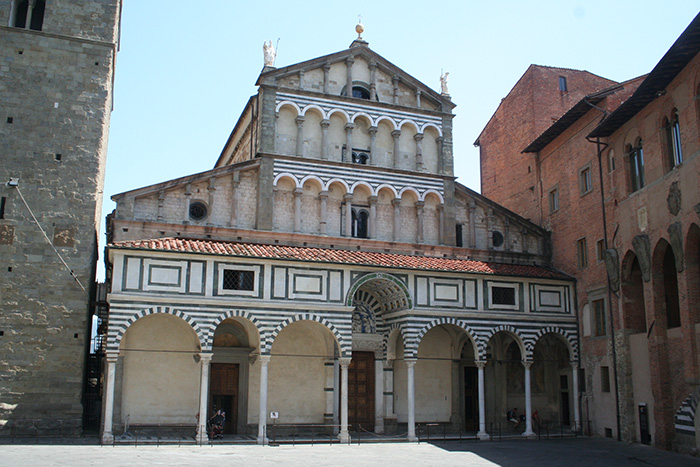| |
|
 |
|
In the square is also the 14th -century Baptistry, in Gothic style, with white and green striped marble revetment characteristic of the Tuscan Gothic.
Baptistery of San Giovanni in Corte
With its fascinating white and green marble, the baptistery of San Giovanni in Corte, originally designed by Andrea Pisano, is one of the highest expressions of Tuscan Gothic architecture as it combines elements of Florence, Pisa and Siena.
The present-day octagonal structure was begun in 1303 and the baptistery took the place (and the name) of a pre-existing church. The elegant and imposing exterior contrasts the simple inside, with bare bricks.
|
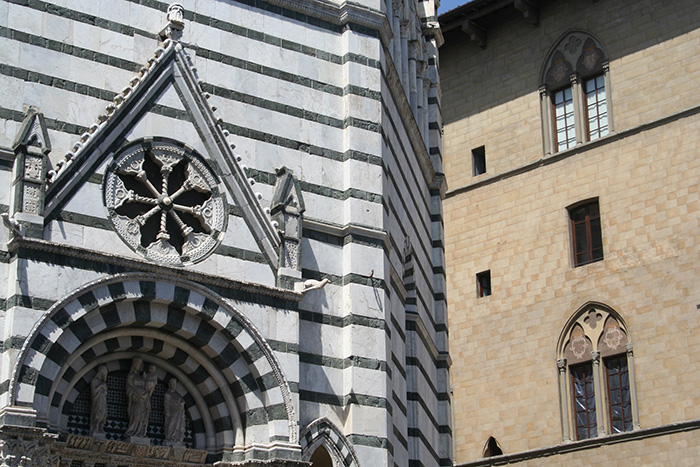
|
Battistero San Giovanni in Corte (particolare)
|
The Baptistery stands opposite the entrance to the cathedral. Known fully as the 'Battistero di S Giovanni in Corte pistoia', it is one of the oldest buildings in Pistoia. The precious gothic building with its two-colored marble exterior is clearly tied to the Pistoian Romanesque tradition but it is known as in corte for its link with the Lombard curtis domini regis.
The tympanum on the main doorway was sculpted by the sons of Andrea Pisano, Nino and Tommaso Pisano. Notice the small pulpit.
Address:
Battistero San Giovanni in Corte, Piazza del Duomo, 51100 Pistoia (PT)
|
|
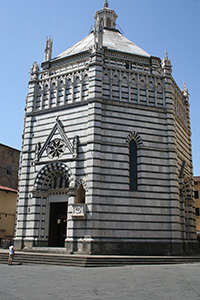
Battistero San Giovanni in Corte |
Other Monuments in Pistoia
|
|
|
Basilica of Our Lady of Humility (Madonna dell'Umiltà)
|
|
|
A miracle attributed to the fresco of the Madonna of humility painted in about 1370 gave rise to the construction of the basilica. The fresco is sometimes attributed to Bartolomeo Cristiani but was perhaps due to a local painter from Pistoia.[1] The basilica, built to designs by architect Ventura Vitoni, is an important example of Early Renaissance architecture. Giorgio Vasari built the octagonal dome atop the basilica in 1562. The original fresco remains within the basilica.[2]
According to legend, on July 17, 1490, in the midst of the infighting between local power factions, some people saw blood dripping from the forehead of the Madonna fresco, which was interpreted as a sign that the Virgin Mary suffered from the bloodshed in the region. The miracle was confirmed by Bishop Niccolò Pandolfini, and the important families of Pistoia decided to build the sanctuary to honor the Madonna.
The Basilica of Our Lady of Humility (Madonna dell'Umiltà) (1509), finished by Giorgio Vasari with a 59-metre (194 ft) high cupola. The original project was by Giuliano da Sangallo, but works were begun in 1495 by Ventura Vitoni. The dome was commissioned by Cosimo I de' Medici to Vasari, the lantern begin completed in 1568 and the church consecrated in 1582. In the apse is a painting by Bernardino del Signoraccio (1493).
|
Church of St.Giovanni Fuoricivitas
|
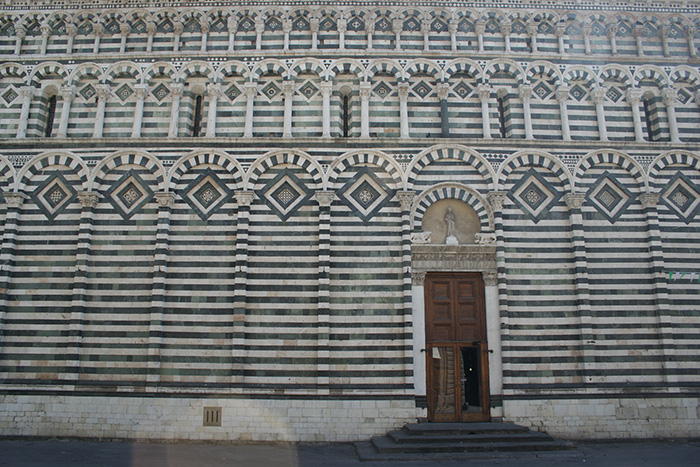
|
Church of St.Giovanni Fuoricivitas
|
The church consecrated to Saint John the Evangelist was called Fuorcivitas because it was built outside the Medieval city wall. The church was definitely built by the early twelfth century and consisted of an apse and a single nave, much smaller than what can be seen today. Of the early form, we can still see the original facing in different colored marbles and the side door which has an architrave sculpted with the Last Supper signed by Gruamonte.
The Church of St.Giovanni Fuoricivitas attracted famous artists who transformed it into one of the most important churches in the city. The high quality of the work is seen not only in the art but also in an important document of mid-century that refers to how the Opera di San Giovanni intended to involve the best artists of the time in the project. These included: Fra' Guglielmo di Pisa who sculpted the reliefs on the pulpit, perhaps Giovanni Pisano, who may have made the basin for holy water; the Master of 1310, who probably began his career with the frescos in the choir; Taddeo Gaddi who left the triptych of the Madonna Enthroned between the saints Jacopo, John the Evangelist, Peter and John the Baptist; Giovanni Cristiani who painted the Scenes of Saint John the Evangelist.
The church, precious for the important works of art that it houses, also contains the Visitation, one of Luca della Robbia's masterpieces, today located in a niche on the northern wall, as well as a rare thirteenth-century Crucifix.[1]
Monuments in Pistoia | Church of St.Giovanni Fuoricivitas
|
|

Pistoia, church of St.Giovanni Fuoricivitas, north side, lion over the sculptured architrave in the main door (12th century)
|
Chiesa San Andria, Church of Sant' Andrea
|
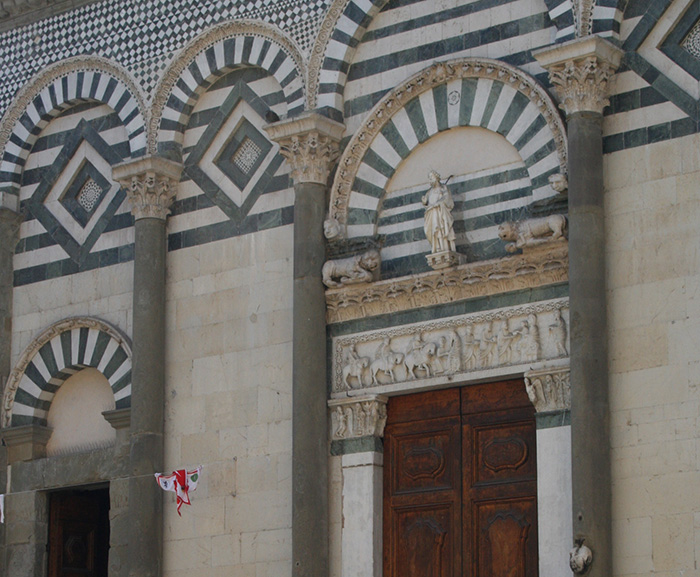 |
Church of Sant' Andrea
|
The church's interior, divided into three naves with columns and a semi-circular apse, can be fully ascribed to the general renewal that involved the major Pistoian churches in the mid-twelfth century. Its appearance today was uncovered by a series of restorations, particularly by the most recent ones which tore out much of the work that had been added over the centuries; today we see a building which is certainly austere and suggestive but different from the original.
The richness of its colors can still be seen in some of the few remaining frescos.
Monuments in Pistoia | Church of Sant' Andrea
|
|

The nave with Giovanni Pisano's pulpit |
| |

|
| Chiesa Chiesa San Andria, Pistoia, Italy [2] |
|
The church houses great works of art that make it one of the most interesting places in the region. Among these, there are the Pulpit sculpted by Giovanni Pisano at the end of the thirteenth century and the wooden Crucifix, on the first altar on the left wall, that Giovanni carved for the Church of Santa Maria Ripalta.
The pulpit at the Chiesa Sant'Andrea is one of Pisano's masterpieces. Henry Moore called Pisano the first modern sculptor.
Monuments in Pistoia | Chiesa di San Andria
Pulpit of San Andrea, Pistoia (Giovanni Pisano)
The pulpit in the church of Sant' Andrea, Pistoia is a masterpiece of 1301 by the Italian sculptor Giovanni Pisano. The work is often compared to the pulpits sculpted by Giovanni's father Nicola Pisano in the Baptistery of Pisa and the Duomo of Siena, which Giovanni had assisted with.
by September 1285 Giovanni Pisano had rejected his Pisa citizenship and had become a resident of Siena. About that time he began his work on the design and sculptural ornamentation of the facade for the cathedral of Siena which became, in its lavishness and ordering, the model for virtually all future Gothic facade decoration in central Italy.
Next to the Siena cathedral facade, Pisano’s pulpit in Pistoia, completed in 1301, is his greatest achievement. [3]
His very advanced works are often described in terms such as "proto-Renaissance", and draw on Ancient Roman sarcophagi and other influences to form a style that represents an early revival of classical sculpture while also remaining Gothic, and drawing on sources such as French ivory carvings.
|
|

Giovanni Pisano's pulpit
|
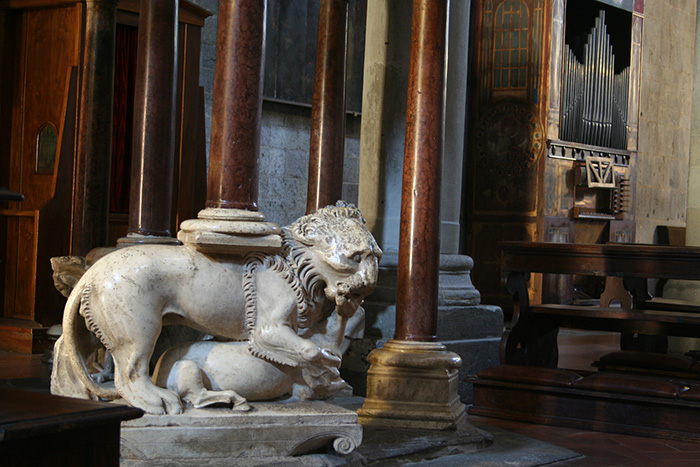 |
Giovanni Pisano's pulpit
|
|
|
|
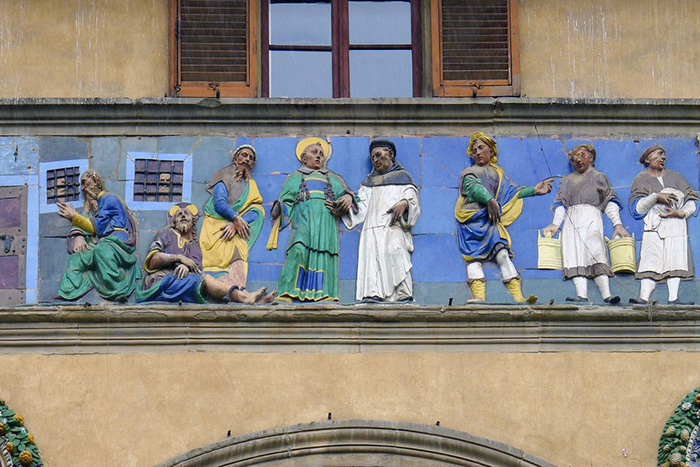 |
Pistoia, Ospedale del Ceppo [4]
|
The Hospital del Ceppo, famous for the Della Robbia frieze that decorates its loggias, is historically a place of welcome and cure in Pistoia. The particular front, the frieze, was created between 1526 and 1528 by Giovanni Della Robbia and his student Santi Buglioni, the nephew of Benedetto Buglioni. The hospital is situated in a square at the end of Via Pacini. The Ospedale del Ceppo, which takes its name from the hollowed-out tree stump (in Italian ceppo) in which alms were traditionally collected. According to an old Pistoia legend, the Virgin Mary appeared to the pious husband and wife Antimo and Bendinella in their dreams and ordered them to found a hospital at the site where a tree stump (ceppo) was found flowering in the middle of winter.
The structure housed a prestigious school of medicine and surgery from the 17th to the 19th centuries.
Established in the thirteenth century, it was embellished in the fifteenth with a portico which, in its general features, recalls those of two great Florentine Hospitals, the Innocenti, and S. Paolo.
The only parts of the building that are accessible are those included in the Pistoia Sotterranea tour.
Monuments in Pistoia | Ospedale del Ceppo
|
|
 |
Pistoia Sotterranea
|
|
|
To the left of the Ospedale, a doorway gives access to Pistoia Sotterranea, an archaeological route almost 700 metres long, revealing a system of medieval underground vaults that were created when a branch of the Brana River was diverted beneath the city, where it drove the Ceppo's olive oil mill and other machines.
Visits, always guided, are intended to reconstruct the various phases of urban development, researched and clarified during the restoration project, and the long story of the Hospital from its founding to today.
Museo dell'Ospedale del Ceppo
Piazza Giovanni XXIII, 15, 51100 Pistoia
|
Events
|
The Giosta dell'Orso (Joust of the Bear)
Already in 1200, according to documents still preserved today, knights and noblemen from various parts of Italy challenged each other to win the tournament's prize, called palio. The palio is often a cloth banner, not exactly precious in itself but for the prestige of winning it.
The Giosta dell'Orso happens every year, on July 25 to celebrate St. James, Pistoia's patron saint. It is a modern twist on the ancient, traditional palio race that has been held here since the middle of the twelfth century.
Since 1947, the Joust has been held in Piazza del Duomo which gets transformed into an oval shaped horse race track.
The manifestation starts at 9 a.m. when each rione (each one of the city sections, which are: Cervo Bianco, Drago, Leon D'Oro and Grifone) leave from their headquarter (one of the four gates of the city: Porta al Borgo, Porta Carratica, Porta Lucchese e Porta San Marco) and march directly to the Cathedral.
The future of the medieval horse race the Joust of the Bear is in doubt. During the 2014 edition, two thoroughbred horses, Oracle and Golden Storming Forces had fallen, and, after a long consultation of doctors, two horses were put down after breaking their legs during the race.
Furthermore, Medina Lasansky's The Renaissance Perfected examines the way in which the late Middle Ages and Renaissance were manipulated and deployed in service of politics during Italy’s Fascist regime between 1922 and 1945. (...) Celebrating the Middle Ages and the Renaissance was central to the discourse of identity politics throughout the history of modern Italy.”[4]
|
|
|
| |
|

[1] Source: Comune di Pistoia
[2] photo made by Mattana
[3] Source: Giovanni Pisano | Italian sculptor | www.britannica.com
[4] From the preface of D. Medina Lasansky, The Renaissance Perfected. Architecture, Spectacle, and Tourism in Fascist Italy, University Park: Pennsylvania State University Press, 2004.
This study of Fascist Italy ‚shows how the regime promoted civic architecture, how it canonized medieval and Renaissance monuments in Tuscany in particular, and how it manipulated popular festivals all in the service of political ideology. Scholars as well as students are still in the grip of this Fascist vision of pre-modern Italy since our textbooks, monographs and lectures fail to take into account the urban redesign, the ‘edited’ monuments, or the ‘invented traditions’ in cities like Siena, Arezzo or San Gimignano’. (Cristelle Baskins, Tufts University)
When visitors to Tuscany admire the towers, town hall, and piazzas in Arezzo, or watch the elaborate palio and calcio storico festivals in Siena and Florence, they might feel as if they had stepped back into the Italian past. Few, if any, would question the authenticity of these structures and events, for they resemble the kind of medieval and Renaissance attractions visitors expect to see there. Yet, all is not as it seems. Many of Arezzo's buildings were thoroughly "medievalized" under Benito Mussolini and the festivals were only (re)introduced in the Fascist period. Throughout Tuscany, the Fascist regime instrumentalized Italy's medieval and Renaissance past, which it termed the "Medievo," just as it appropriated the legacy of ancient Rome in the capital. Whether through the restoration of existing buildings, the design of new ones, or the creation and promotion of public spectacles, between 1922 and 1945, the Medievo served political ends: strengthening Italian national identity, celebrating the Fascist regime, and honoring the achievements of Il Duce himself. By highlighting the region's medieval/Renaissance past, the regime also encouraged tourism to the area. [From The Renaissance Perfected reviewed by Kristin Semmens (Department of History, University of Victoria, Canada), published on H-Travel (October, 2006) |www.networks.h-net.org]
|
This article incorporates material from the Wikipedia articles Pistoia,
Basilica of Our Lady of Humilitypublished under the GNU Free Documentation License.
Wikimedia Commons has media related to Pistoia
|

Tuscany Holiday Homes | Podere Santa Pia
|
| |
|
|

|
Podere Santa Pia. View on the valley below Podere Santa Pia, characterized by all the elements of the Tuscany landscape: vineyards, pastures, wheat fields and olive groves.
|

Section 14 of the Via Francigenas one of the most popular and spectacular sections of the Via Francigena. It starts in the walled city of Lucca with its amazing Renaissance wall and citadel, and finishes in the UNESCO World Heritage historic centre of Siena.
|
|
|
![]()
![]()
![]()
![]()
![]()

